Abstract
Termination analysis is an essential part in programming. Especially quantum programming concerning measurement, entanglement and even superposition are the foundations of bizarre behaviours in quantum programs. In this paper, we analyse and extend the theoretical theorems on termination analysis proposed by Ying et al. into computational theorems and algorithms. The new algorithm without the Jordan decomposition process has a significant acceleration with polynomial complexity both on terminating and almost-surely terminating programs. Moreover, the least upper bound of termination programs steps is studied and utilized to output the substituted matrix representation of quantum programs. We also implement four groups of experiments to illustrate the advantages of the new algorithm in case of processing a simplified quantum walk example comparing with the original counterpart.
Similar content being viewed by others
References
Bourdoncle F. Abstract debugging of higher-order imperative languages. SIGPLAN Not, 1993, 28: 46–55
Cook B, Podelski A, Rybalchenko A. Termination proofs for systems code. In: Proceedings of the 27th ACM SIGPLAN Conference on Programming Language Design and Implementation, 2006. 415–426
Brockschmidt M, Cook B, Ishtiaq S, et al. T2: temporal property verification. In: Proceedings of International Conference on Tools and Algorithms for the Construction and Analysis of Systems, 2016. 387–393
Ying M S. Foundations of quantum programming. In: Proceedings of the 8th Asian Conference on Programming Languages and Systems, 2010
Ying M S, Feng Y. Quantum loop programs. Acta Inform, 2010, 47: 221–250
Ying M S, Yu N K, Feng Y, et al. Verification of quantum programs. Sci Comput Program, 2013, 78: 1679–1700
Li Y J, Yu N K, Ying M S. Termination of nondeterministic quantum programs. Acta Inform, 2014, 51: 1–24
Yu N K, Ying M S. Reachability and termination analysis of concurrent quantum programs. In: Proceedings of International Conference on Concurrency Theory, 2012. 69–83
Li Y J, Ying M S. Algorithmic analysis of termination problems for quantum programs. In: Proceedings of ACM on Programming Languages, 2017
Horn A R, Johnson R C. Matrix Analysis. Cambridge: Cambridge University Press, 1990
Paulsen V. Completely Bounded Maps and Operator Algebras. Cambridge: Cambridge University Press, 2002
Beelen T, van Dooren P M. Computational aspects of the Jordan canonical form. In: Reliable Numerical Computation. Oxford: Clarendon Press, 1990. 57–72
Liu S S, Zhou L, Guan J, et al. Q|SI〉: a quantum programming environment (in Chinese). Sci Sin Inform, 2017, 47: 1300–1315
Acknowledgements
This work was supported by National Natural Science Foundation of China (Grant Nos. 61672007, 11771011, 11647140). We were grateful to Ying DONG for his helpful dicussions.
Author information
Authors and Affiliations
Corresponding authors
Rights and permissions
About this article
Cite this article
Liu, S., He, K. & Duan, R. Implementing termination analysis on quantum programming. Sci. China Inf. Sci. 62, 222501 (2019). https://doi.org/10.1007/s11432-018-9847-0
Received:
Revised:
Accepted:
Published:
DOI: https://doi.org/10.1007/s11432-018-9847-0




